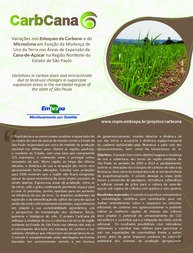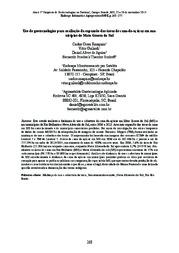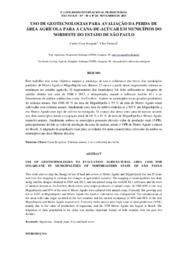CarbCana – Variations in Carbon Stock and Microclimate due to Land-Use Changes in Sugarcane Expansion Areas in the Northeast Region of the State of São Paulo
CarbCana – Variations in Carbon Stock and Microclimate due to Land-Use Changes in Sugarcane Expansion Areas in the Northeast Region of the State of São Paulo

Photo: BENCHEKCHOU, Zineb
The national and international demand for ethanol and the increasing concerns with world climatic changes is generating the expectation of an increase in the use of biofuels and consequently an increase in the area planted with sugarcane in Brazil. Brazil is the largest producer and exporter of sugarcane products in the world, and the state of São Paulo has been responsible for nearly half of the national production in the latest years. Among the state's regions, the northeastern portion, which comprises 125 municipalities, is known as the main sugarcane center in the country. Along the last decades, the land-use and cover dynamics at the region has been showing strong changes. Even though there are nearly no untouched areas to be opened, projections made by studies for 2030 show that the region will not remain stationary. Expressive production areas, such as citrus, coffee and grain areas, will continue to lose space for sugarcane. Nevertheless, forecasts point to an increase in land-use efficiency. The environmental impacts of sugarcane expansion and intensification have not been sufficiently studied yet, especially when it comes to their agronomic sustainability in terms of the maintenance of physical, chemical, and biological soil attributes. The CarbCana project focuses on the land-use and cover changes at the northeast region of the state of São Paulo along the last ten years and on the consequent change in carbon stock and climate variables which influence air temperature. The study is supplemented by territorial approaches based on remote sensing and on geoprocessing techniques, with the aim of detecting the land-use dynamics and of associating them to the spatial-temporal dynamics of the carbon imprisoned by the agricultural ecosystem's phytomass and soil, as well as of the air temperature. The project's objective is to map land-use and cover changes at the northeast region of the state of São Paulo from 2003 to 2013, and to concurrently estimate the changes in carbon stock and phytomass, as well as changes in air temperature which derive from the evapotranspiration. The study encompasses areas where pastures, citrus crops, coffee crops and other annual grain crops have been converted to sugarcane, which is harvested both with burning and with no burning. The study aims to produce zonings and scientific methods which will contribute to a better understanding of the sequestration process or of additional carbon emissions in the agricultural ecosystems, and may then point to the best crop management options to amplify the atmospheric CO2 storage potential and thus further contribute to the mitigation of the greenhouse effect. The results enable creating environmental indicators and more effective subsidies to place the country ahead of other lands in commodities' negotiations, and generating positive impacts on the environmental valuation of agricultural production systems. For more information, please access: http://www.cnpm.embrapa.br/projetos/carbcana/
Status: Completed Start date: Thu Nov 01 00:00:00 GMT-03:00 2012 Conclusion date: Sat Oct 31 00:00:00 GMT-03:00 2015
Head Unit: Embrapa Territorial
Project leader: Carlos Cesar Ronquim
Contact: carlos.ronquim@embrapa.br



